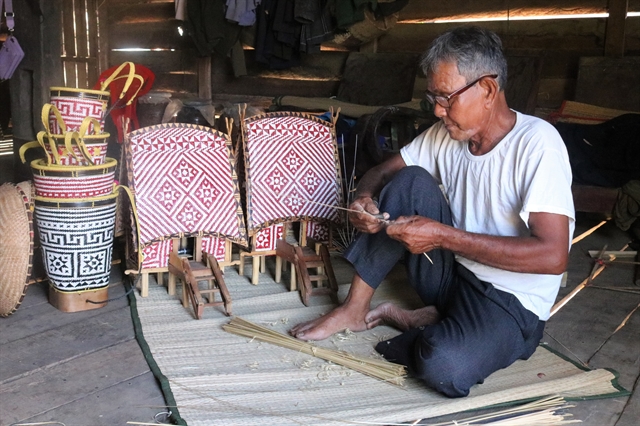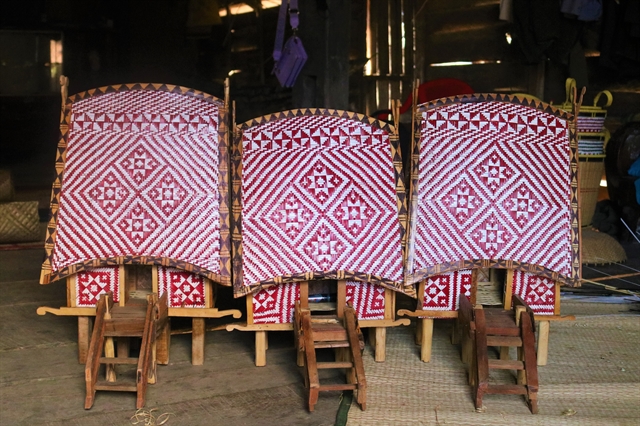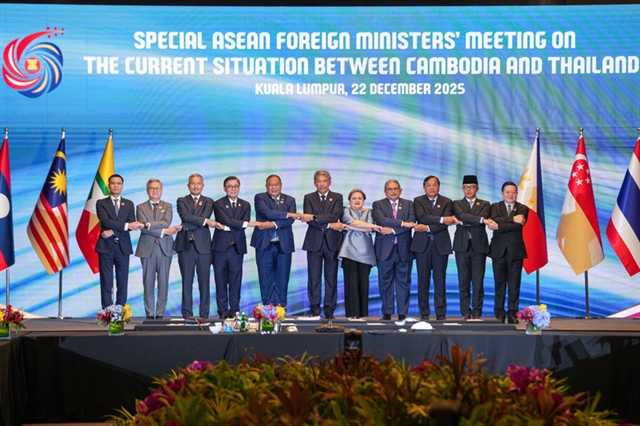 Sunday/Weekend
Sunday/Weekend

 |
| ARTISAN: Đinh Nhiêu is seen splitting bamboo strips that will be used to weave miniature communal houses or domestic utensils. VNS Photos Nay Sắt |
By Nay Sắt & Lương Hương
To the Bahnar ethnic minority, the long communal house, a variation of the stilt houses unique to the Central Highlands region, is an invaluable part of their culture and a symbol of pride.
To teach future generations about the symbolic meaning of the traditional house, an artisan in Plei Kte Village in the central province of Gia Lai has weaved many miniature communal houses from bamboo wicker.
The tiny ethnic houses have become unique souvenirs for visitors to the locality and provide their maker Đinh Nhiêu with a stable source of income.
Nhiêu learned how to use bamboo to make household wicker utensils from his father when he was 13 and has been pursuing the craft ever since. The 68-year-old is among the few bamboo-weaving artisans in the village.
With his skilful hands, Nhiêu has weaved a variety of items, such as baskets, pots and mats. But the most impressive is the tiny communal houses with the typical designs and sophisticated patterns.
“I had to carefully study the traditional houses' design to perfect my products. The hardest thing was learning how to assemble the structure of a real home into a miniature. It took me a while to create my first one,” Nhiêu said.
 |
| WEAVING HOPE: Another best-selling product is the bamboo-woven backpack. |
The artisan also paints colours on bamboo strips to make his miniature houses more eye-catching and highlight their patterns.
The models are manually made, but to shorten the weaving time and ease the workload, he has also bought some machines such as nail guns and bamboo cutters. Nhiêu expects his products to be firm, durable and beautiful to satisfy customers.
Besides the traditional houses, another of his best-selling products is bamboo-woven backpacks.
“I used to weave simple baskets to carry farm or forest products. After seeing a woman using it to hold colourful handloom fabrics, I came up with the idea to decorate the backpacks with patterns and make it sturdier by weaving two layers,” the artisan said.
 |
| TINY TRINKETS: The miniature traditional houses have become unique souvenirs for visitors but also provide artisan Đinh Nhiêu with a stable source of income. |
His bamboo products have become renowned far and wide; tourists and locals from nearby villages frequently purchase them.
It usually takes around 10 days to complete a miniature communal house and at least 14 days to weave a backpack.
Making the product takes many elaborate stages, such as preparing, painting and weaving the raw materials. Notably, the bamboo must be split into thin, flat sticks that ensure softness and smoothness to facilitate the weaving.
Customers must order the products in advance. The price of a miniature house ranges from VNĐ800,000 to 1,200,000 (US$32-48), and a backpack goes from VNĐ300,000 to 800,000.
Not many youths in the area are interested in bamboo weaving, as it takes much time and effort to craft an item. The traditional craft faces the risk of being lost.
Artisan Nhiêu contributes to preserving the craft by frequently holding free classes at his house where young villagers can learn basic bamboo weaving techniques.
“Nhiêu used to be the enthusiastic chairman of the Farmers' Association of Phú Thiện District. When he retired, he came up with many ideas to create products to preserve our cultural values, one of which was the miniature communal houses,” said Nay Bang, chief of Plei Kte Village.
“He is renowned as a skilful bamboo weaver in the village. The local authorities have supported him to produce innovative products and will introduce them at festivals and fairs.” VNS




